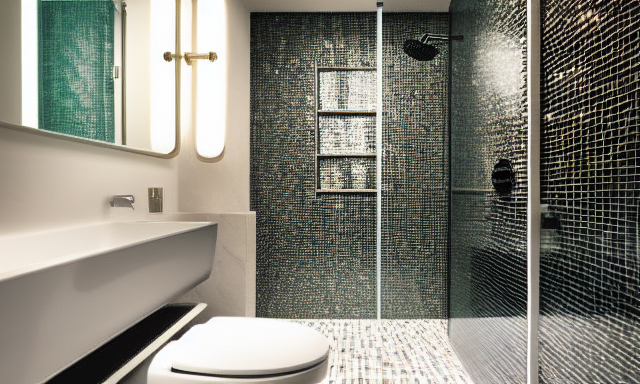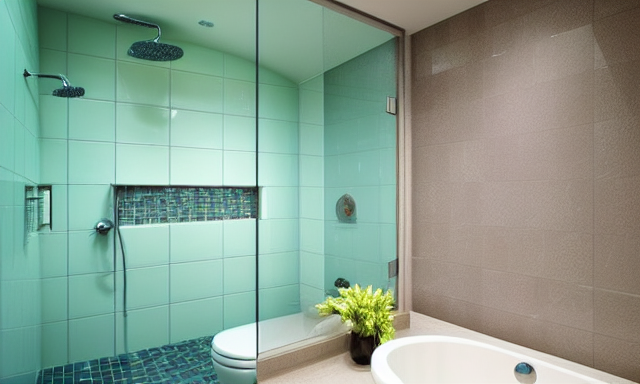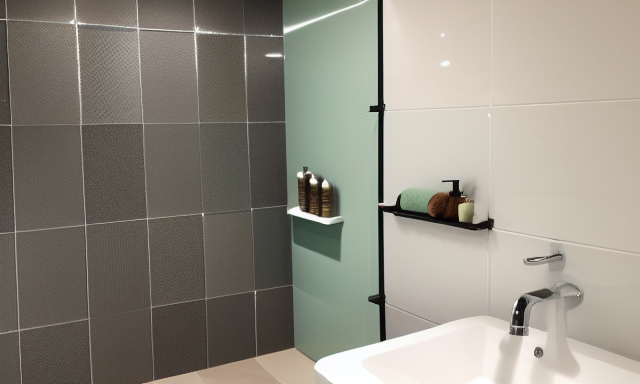Designing an accessible bathroom is crucial for ensuring safety, comfort, and independence for people with disabilities or mobility impairments. A bathroom can be transformed into a functional and welcoming space with the right design elements. This article will provide an overview of 15 design ideas for an accessible bathroom.
In This Article
Toggle
1) Lighting
Proper lighting is essential accessibility features for an accessible bathroom. The use of bright lighting helps to ensure visibility, especially for those with visual impairments. Installing motion sensor lights can also provide convenience and safety, allowing users to move around the bathroom without the need for a physical switch. For example, a motion sensor light can be installed above the bathroom mirror, automatically turning on when someone enters the room.
2) Doorways
A bathroom with a wide doorway can be a game-changer for people who use wheelchairs or walkers. The installation of a sliding door can also improve accessibility, as it requires less space to operate than a hinged door. For instance, a sliding door with a wide opening can be installed in place of a traditional hinged door to accommodate a wheelchair user.
3) Grab Bars
Grab bars are an essential safety feature in an accessible bathroom ideas Singapore. Proper placement of grab bars can provide support and stability for people with mobility impairments. Installing colored grab bars can also help to create contrast with the surrounding walls, making them more visible and easier to locate. For example, a contrasting-colored grab bar can be installed next to the toilet, providing support for those with mobility issues.

4) Toilet
The toilet is a vital element of any bathroom layout, and installing a raised toilet seat can make it more accessible for people with mobility impairments. A bidet toilet can also be an excellent addition to an accessible bathroom, providing users with a convenient and hygienic alternative to traditional toilet paper. For instance, a raised toilet seat with an attached bidet can be installed to provide added comfort and convenience.
5) Sinks and Counters
Adjustable sinks and counters can make a bathroom more accessible for people with different heights and mobility needs. Wall-mounted sinks can also create more space in the bathroom, making it easier to maneuver a wheelchair or walker. For example, an adjustable sink can be installed with a lever that allows users to adjust the height of the sink to their needs.
6) Shower and Bathtub
Roll-in showers and walk-in bathtubs can make a significant difference in the accessibility of a bathroom. A roll-in shower eliminates the need for a threshold, making it easier for wheelchair users to enter and exit the shower. A walk-in bathtub provides a safer and more accessible bathing option for people with mobility impairments. For instance, a roll-in shower with a fold-down seat and handheld showerhead can be installed to provide added comfort and convenience.
7) Non-slip Flooring
Textured flooring and anti-slip strips can improve safety in an accessible bathroom, reducing the risk of slips and falls. Textured flooring provides extra traction, while anti-slip strips can be installed in the shower or bathtub to prevent slipping. For example, textured flooring with anti-slip strips can be installed throughout the bathroom to create a safer and more accessible environment.

8) Mirrors
Proper placement of mirrors can make a bathroom more accessible for people with different heights and mobility needs. Installing adjustable mirrors can also make it easier for people with mobility impairments to see themselves. For example, an adjustable mirror can be installed on a pivot arm, allowing users to adjust the angle and height of the mirror to their needs.
9) Accessibility to Amenities
The placement of amenities within reach is an important consideration in an accessible bathroom. Touchless faucets and soap dispensers can make accessing these amenities easier for people with mobility impairments without needing physical contact. For instance, a touchless faucet and soap dispenser can be installed next to the sink, providing easy access.
10) Use of touchless faucets and soap dispensers
Touchless faucets and soap dispensers are another great option for an accessible bathroom. They eliminate the need for the user to grip and turn knobs or handles, making them easier to use for people with limited mobility.
11) Installation of emergency call buttons
For individuals with disabilities, it’s important to have emergency call buttons installed in case of an accident or injury. These buttons can be easily accessed and used to call for help. They can be installed in various locations throughout the bathroom, including the toilet, shower, and bathtub. These buttons can be connected to a monitoring system that will notify emergency services in case of an emergency.
12) Use of voice-activated systems
Assistive technology has revolutionized the way we approach accessibility in the bathroom. Voice-activated systems such as Amazon’s Alexa or Google Assistant can help individuals with disabilities navigate their daily routines more efficiently. Users can use voice commands to control lighting, adjust the temperature, and even turn on faucets. For instance, a person with limited mobility can say, “Alexa, turn on the shower,” and the system will take care of the rest.

13) Use of wider spaces
When designing an accessible bathroom for wheelchair users, it’s essential to ensure that there is enough space for them to maneuver comfortably. This includes wider doorways, larger bathroom stalls, and more open space around the toilet and sink. For instance, a bathroom designed for wheelchair users should have at least 60 inches of turning space in every direction.
14) Use of contrasting colors
Using contrasting colors in an accessible bathroom can help individuals with visual impairments navigate the space more easily. For instance, using a contrasting color for grab bars can make them more visible and easier to use. Similarly, using a contrasting color for the toilet seat can make it easier to locate.
15) Installation of transfer benches
Transfer benches are an essential feature of an accessible bathroom for wheelchair users. These benches can be installed in the shower and bathtub to help individuals with limited mobility safely get in and out of the water. They are designed to support up to 400 pounds and can be adjusted to the user’s height and weight.

Revamp your bathroom with Todzterior – Designing dreams come true
We’re here to help you get started with Smart Home solutions.
Todzterior is the only company whose mission is to make homes “Smart.” In other words, our Smart Home solutions are built to help make your life easier. The possibilities for the future of the smart home are endless. You’ve come to the right place. We’re here to help you get started with Smart Home solutions and ensure you with smart quality and reliability.
Don’t hesitate to find out more about us. Call us here or visit our showroom at 7 Gambas Crescent #01-03 Ark@Gambas Singapore 757087.
